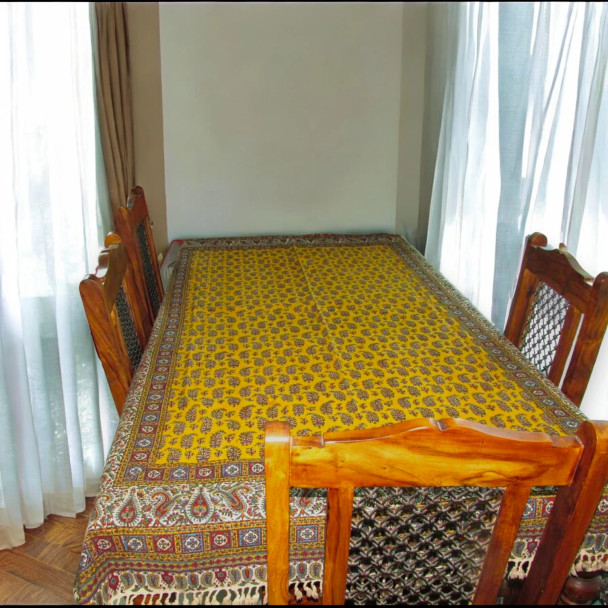How to Protec and Wash Persian Ghalamkari Tablecloths
Persian Ghalamkari fabric is a cherished piece of Iran's rich cultural heritage, particularly popular among artisans in Isfahan. This traditional art form involves printing intricate patterns on fabric using specially designed molds and beautiful dyes. The designs, often inspired by nature, feature motifs like boteh jegheh, birds, and flowers, reflecting the timeless beauty of Persian artistry. Despite its elegance, many owners of Ghalamkari fabrics face challenges in maintaining and cleaning them properly. This guide provides essential tips for preserving the beauty and longevity of these exquisite textiles.
Key Tips for Maintaining Persian Ghalamkari Fabric
- Washing Ghalamkari Fabric
One of the most crucial aspects of fabric care is washing. Many people struggle with this process, potentially damaging their valuable textiles. To wash Ghalamkari fabric, it’s important to first identify the type of fabric. Natural fibers like silk and cotton are more delicate and should not be machine washed. Instead, hand washing is recommended.
Hand Washing Instructions:
- Soak the fabric in a basin of cold water.
- Add a small amount of mild soap or shampoo to the water and gently agitate to create suds.
- After soaking, gently scrub the fabric with your hands or a soft brush.
- Rinse thoroughly in cold water to remove all soap residues.
- Avoid using strong detergents, bleach, or chemical stain removers, as these can damage the fabric’s weave and design.
- Do not leave the fabric in water for too long to prevent damage to the fibers.
- Drying Ghalamkari Fabric
After washing, it’s essential to dry the fabric properly to avoid any potential damage.
Drying Techniques:
- Air Drying: Lay the fabric flat on a clean, dry surface in a shaded area. Avoid direct sunlight, which can fade the colors. Let it dry naturally in the open air.
- Using a Hair Dryer: For quicker drying, use a hair dryer on a low heat setting. Maintain a distance of at least 30 centimeters from the fabric and avoid focusing on one spot to prevent localized heat damage.
- Towel Drying: Place a lint-free towel over the fabric and press gently to absorb excess water. Avoid wringing or twisting the fabric, as this can distort the pattern and fabric structure.
- Ironing Ghalamkari Fabric
While generally not recommended due to the risk of high heat damage, occasional use of an iron can be helpful for removing wrinkles.
Ironing Instructions:
- Set the iron to the lowest heat setting and use a pressing cloth between the iron and the fabric to protect the design.
- Iron gently and avoid direct contact with the fabric’s surface.
- Storage
When not in use, store Ghalamkari fabric in a dry, cool place away from direct sunlight. This prevents fading and helps preserve the fabric’s quality over time.
Conclusion
Persian Ghalamkari fabric, a treasure of Iranian art, requires careful handling to maintain its beauty. Hand washing in cold water, air drying away from direct sunlight, and gentle ironing with precautions are key practices for preserving this delicate textile. By following these guidelines, you can ensure that your Ghalamkari tablecloth remains a stunning piece of art for years to come.
Frequently Asked Questions
- What is the best way to wash Ghalamkari fabric? Hand washing in cold water is recommended for preserving the fabric’s quality.
- Can I use bleach on Ghalamkari fabric? No, bleach and strong chemicals can damage the fabric’s design and fibers.
- Should I hang Ghalamkari fabric to dry? Avoid hanging the fabric to prevent distortion. Lay it flat to dry.
- Where is the best place to store Ghalamkari fabric? Store it in a cool, dry place away from direct sunlight to prevent fading.
Recent Posts
-
Sustainable Splendor: The Eco-Friendly Soul of Handcrafted Art
In an era of fast fashion and mass-produced home decor, the environmental cost of our "stuff" has ne …31st Dec 2025 -
The Art of Diplomacy: Why Handcrafted Heritage is the Language of Dubai’s Protocol
In the world of international relations and government protocol, a gift is never "just a gift." It i …31st Dec 2025 -
The Psychology of Appreciation: Using Bespoke Art to Retain Top Talent in Dubai
In the high-speed corporate environment of Dubai, where the global hunt for talent is relentless, a …31st Dec 2025





